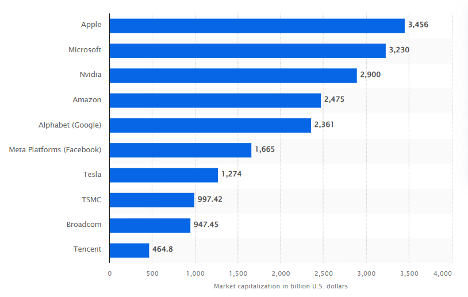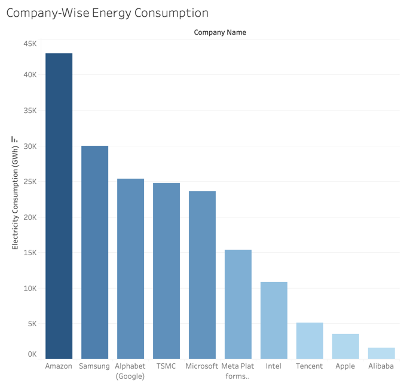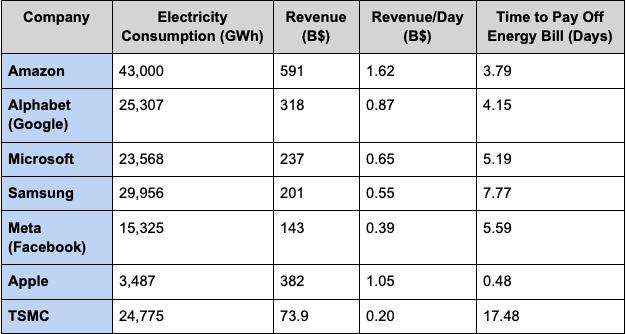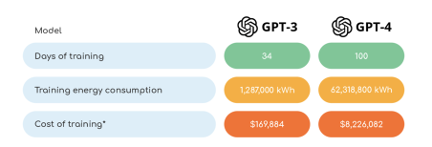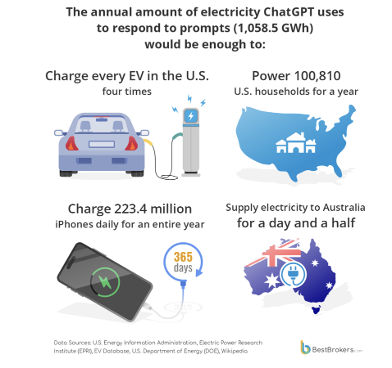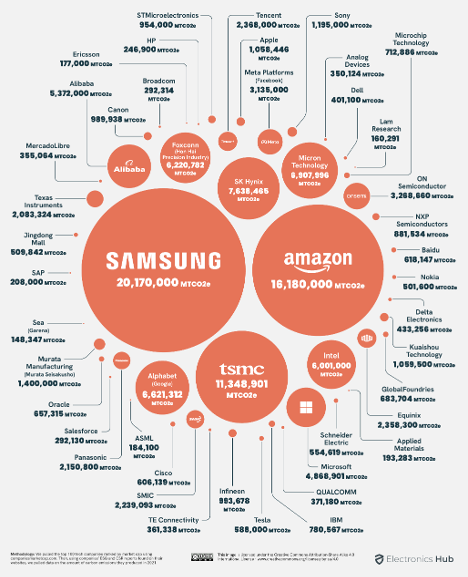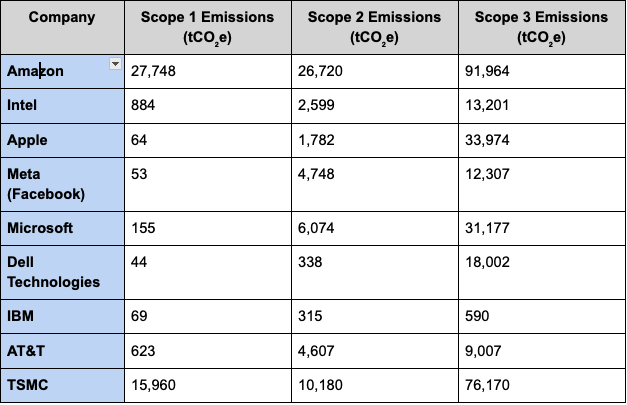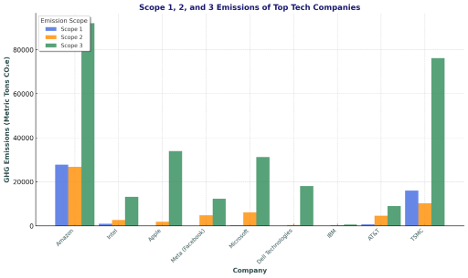
The Carbon Footprint of Big Tech: Energy Consumption, Emissions, and the Future of Sustainability
The rapid expansion of the digital economy, artificial intelligence (AI), and cloud computing has placed Big Tech at the center of global energy consumption and greenhouse gas (GHG) emissions. Companies such as Amazon, Microsoft, Alphabet (Google), Apple, Meta, and TSMC wield immense economic influence, often surpassing the GDP of small nations. With this power comes responsibility: their operations - particularly data centers and supply chains - drive significant environmental impact.
2025 Global Market Capitalization of
Leading Tech companies
II. Big Tech’s Market Share and Energy Consumption
Tech companies dominate the global economy, with combined revenues reaching trillions of dollars annually. They also consume staggering amounts of electricity, often comparable to medium-sized countries.
Bridging the Data with Real-World Comparisons
Understanding the scale of Big Tech’s energy consumption requires more than raw numbers. To put things in perspective, Amazon consumes more electricity annually than Austria, while TSMC’s energy use surpasses that of Cuba. These comparisons underscore the need to treat major corporations not just as businesses but as entities with planetary-scale impact.
The reality is that the growth of the digital economy is now tightly linked to global energy demand, making tech giants key players in the world’s shift toward renewables - or continued dependence on fossil fuels. The question is no longer just about efficiency improvements but whether these companies will shape energy markets or be shaped by them.
Annual Electricity Consumption (GWh) & Revenue of Top Tech Companies
Amazon consumes more electricity than Austria, while TSMC uses more power than Cuba.
The Role of AI and Cloud Computing in Energy Use
- Data centers account for a significant share of electricity demand, with global consumption projected to reach 536 TWh by 2025 (2% of global electricity use).
- AI models such as GPT-3 consume as much electricity in training as 130 U.S. homes use annually.
- The growth of AI is driving demand for natural gas power plants, despite sustainability commitment
Why Tech’s Energy Growth is Unique
Unlike industries that primarily burn fossil fuels, Big Tech’s footprint comes from electricity use - especially data centers, AI models, and cloud computing infrastructure. These facilities require continuous operation, meaning energy consumption cannot be easily curtailed without disrupting essential services. The energy demands of AI training alone are outpacing global renewable energy capacity, a troubling sign for companies that claim sustainability leadership.
Moreover, while governments regulate energy use within their borders, tech companies transcend national policies, operating data centers worldwide based on cost, tax incentives, and power availability. This allows them to shift operations to locations with weaker environmental oversight, further complicating global sustainability efforts.
III. Greenhouse Gas (GHG) Emissions: How Tech Compares to Countries
Tech companies are among the largest global emitters, with emissions comparable to national economies. Scope 3 emissions - supply chain, product use, and logistics - account for 70-98% of their total footprints.
GHG Emissions of Leading Tech Companies
Comparisons to Country-Level Emissions
- Amazon’s total emissions (~146,432 tCO₂e) are larger than the entire annual carbon footprint of Iceland.
- TSMC emits more than Malta.
- Scope 3 dominates all companies, meaning emissions from supply chains far exceed their operational footprints.
The Problem of Offsets and Greenwashing
Many firms claim “carbon neutrality” through carbon offsets rather than actual emissions reductions. Investigations reveal that actual emissions could be 662% higher than reported figures due to over-reliance on renewable energy certificates without reducing on-site fossil fuel use.
How Governments Struggle to Regulate Big Tech’s Emissions
Governments worldwide are mandating stricter carbon reductions for nations and industries, but tech firms operate largely outside of these regulations. While countries negotiate emissions caps under the Paris Agreement, corporations with national-scale emissions remain free to expand their energy use with minimal oversight.
For instance, while the European Union has committed to a 55% reduction in emissions by 2030, none of the major tech companies are legally required to meet similar targets. Big Tech’s emissions rival those of entire nations, yet they lack the accountability imposed on governments.
If corporations are to be treated like sovereign economic forces - shaping global supply chains, controlling infrastructure, and influencing public policy - should they not also be held to similar climate commitments? This remains one of the most pressing policy debates in the intersection of technology and climate regulation.
IV. Future Outlook & The Need for Global Standards
Projected Emissions and Sustainability Goals
- Microsoft and Apple aim for carbon neutrality by 2030.
- Amazon targets 100% renewable energy by 2025.
- Despite pledges, AI and cloud expansion are driving emissions up.
Policy & Regulation: Countries vs. Companies
- Governments face strict emissions targets (e.g., EU’s 55% cut by 2030).
- Tech companies are not bound by the same rules despite emissions rivaling nations.
- U.S. policy shifts (e.g., Green Deal reversals) reduce pressure on firms to decarbonize.
Tech CEOs: The Power of World Leaders?
Tech executives like Jeff Bezos, Tim Cook, and Sundar Pichai wield influence comparable to heads of state due to their companies’ revenue (rivaling national GDPs), emissions (surpassing entire countries), and control over global infrastructure.
A Proposal for Global Standards:
- Threshold-Based Accountability → If a corporation’s emissions exceed those of a nation (e.g., Malta or Iceland), it should be subject to global reporting requirements akin to national governments.
- Binding Emissions Targets → Companies should be legally required to meet sustainability goals, not just self-imposed targets.
- Incentives for True Carbon Reduction → More stringent limits on carbon offsets to prevent greenwashing.
The data is clear: Big Tech’s environmental footprint rivals national economies. While these companies tout their sustainability goals, their emissions - particularly Scope 3 - continue to rise. With AI, cloud computing, and data centers expanding, corporate responsibility must match the level of accountability faced by governments. Without binding international standards, true sustainability remains an illusion.
References:
Energy Information Administration:
https://www.eia.gov/
U.S. Environmental Protection Agency (EPA):
Greenhouse Gas (GHG) Emissions and Removals
Science Based Targets initiative (SBTi):
Ambitious Corporate Climate Action
The Guardian:
Data center emissions probably 662% higher than big tech claims
International Energy Agency (IEA)
https://www.iea.org/
United Nations Framework Convention on Climate Change (UNFCCC)
https://unfccc.int/
Global Carbon Atlas
http://www.globalcarbonatlas.org/
Greenpeace "Clicking Clean" Report
https://www.greenpeace.org/
MIT Technology Review – Climate & Energy
https://www.technologyreview.com/
European Commission's Emissions Database for Global Atmospheric Research (EDGAR): https://edgar.jrc.ec.europa.eu/report_2024.edgar.jrc.ec.europa.eu+1edgar.jrc.ec.europa.eu+1
Our World in Data: https://ourworldindata.org/co2-and-greenhouse-gas-emissions.ourworldindata.org+1ourworldindata.org+1
World Resources Institute (WRI): https://www.wri.org/insights/4-charts-explain-greenhouse-gas-emissions-countries-and-sectors.wri.org


